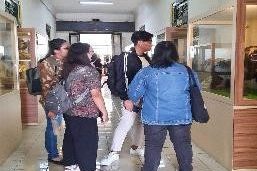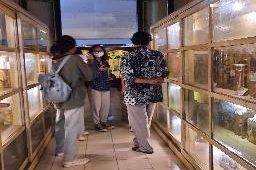Thursday, 16 November 2023, the museum of biology received a student visit from the biology education study program, Faculty of Teacher Training and Education, Sanata Dharma University, Yogyakarta.The visit consisted of 38 attendees, including 30 students (practicum participants), 6 assistants, and 2 professors, marking the first visit after the COVID-19 pandemic. The visit was part of practicum activities for the Animal Structure, Development, and Function course. The visit was warmly welcomed by the museum’s collection caretaker, FX. Sugiyo Pranoto, who oversees the vertebrate animal collection. The visit involved observing and discussing the preserved vertebrate animal collection on display in the museum’s exhibition area.
Assistant Christo Ray Arta expressed that the visit to the Museum of Biology aimed to observe the characteristics of vertebrate animals, study taxidermy and skeletons, and enhance their knowledge gained from prior literature studies, providing valuable insights for their upcoming practical work involving specimen preservation. The student was divided into 8 teams, and as part of the practical visit, each group was tasked with creating an educational video. “It’s great to see biological specimens like preserved wet and dry vertebrates, and it’s amazing to witness the variety of species on Earth in real life.” expressed Handri, one of the students.
The Museum of Biology offers a comprehensive collection that serves as a valuable learning resource for students, as highlighted by accompanying lecturer Yoanni Maria Lauda Feroniasanti, M.Si (Nia), who is also an alumnus of the UGM Faculty of Biology. She mentioned, “We scheduled a visit to the Museum of Biology to see specimens that are rarely or challenging to find, such as structures, morphology, bones, taxidermy, and wet specimens, as our facilities for preservation are limited.” The next practical session will involve creating skeletal specimens, hence the preliminary visit to the Museum to enhance their understanding by examining examples of skeletal structures and preservation methods like taxidermy models. The output from this activity is educational videos. This is to encourage students, as future educators, to create educational content that can be uploaded to social media. However, these videos will undergo review and evaluation by lecturers to ensure accuracy and avoid misinformation before being uploaded. Approved videos related to such external activities will be uploaded to the study program’s website. The visits to the museum of Biology will be scheduled annually, Nia, was impressed with the comprehensive collection and the well-maintained and neatly arranged preservation, despite a few areas needing cleaning. The hope is to incorporate digital technology elements (IT) into each room to make it more engaging, such as simulation displays or self-searching facilities. It’s expected that the available collection information will not only include specimen names, types, curators, but also tell the stories behind these collections, including their discovery locations, unique characteristics, and other relevant details.
The Museum of Biology, despite its limitations, continuously strives to improve and attract visitors by enhancing its facilities and infrastructure, creating thematic spaces, enriching information, conducting collection research, planning public programs, and considering innovations to accommodate visitors with special needs. The aim is for every visitor to leave with a memorable experience and renewed enthusiasm for learning, as expressed by the Museum’s managers, Ida Suryani and Murdianto.





